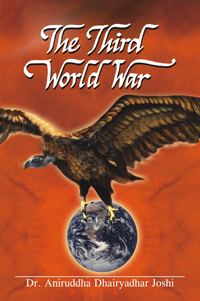Author Publication date 4 December 2006 Country India | Language English, Marathi Originally published 4 December 2006 | |
 | ||
Publisher Lotus Publications Private Limited Media type Print (hardback & paperback) Pages 272 pp (first edition, hardback) | ||
The Third World War Book is a study of the global events that traces the origins of the First World War and Second World War and examines the cascading effect these wars are likely to have, that will unravel in the times to come in the form of a Third World War.
Contents
It is an attempt of the author to acquaint ordinary people with the rapidly changing global situation and how, as ordinary citizens, one should protect oneself from the eventuality and consequences of the war.
Author
Dr. Aniruddha D. Joshi (M.D. Medicine, Rhuematologist, also known as Aniruddha Bapu), a keen follower of international affairs, had written a series of editorials in the daily newspaper Pratyaksha on the topic of Third World War between 26 March 2006 to 16 April 2006. In December 2006, a compilation of his editorials was published in this book. Dr. Aniruddha Joshi conceptualized and gave shape to Aniruddha’s Academy of Disaster Management (AADM) in 2001.
Contents
The book is broadly divided into two sections (a) Third World War and (b) Modern weaponry and its impact.
Third World War
Chapters 1 to 5: These chapters trace the origin of the last two world wars and how nations used their political ambitions of economic supremacy in World War I and, thereafter, in World War II, used the logic of racial supremacy to justify all wrongdoings.
Chapters 6 and 7: These chapters cover the post Second World War scenario, the emergence of Americas as a super power, the Cold War between America and the Soviet Union and the role of the U.S. Central Intelligence Agency in it.
Chapters 8 to 10: These chapters compare the current global situation with the situation that led to the Second World War.
Chapter 11: Position and significance of India in world politics and the emergence of the triad of China, Pakistan and North Korea.
Chapters 12 to 16: Emergence of international terrorist groups, their leaders, such as Osama bin Laden, Abu Musab al-Zarqawi and their strategies.
Chapters 17 to 18: The history and current position of countries such as Pakistan and Afghanistan in world affairs.
Chapter 19: This chapter is divided into various sub-topics which cover the following points:
Modern weaponry and its impact
This section is again a collection of a series of editorials published in the daily newspaper Pratyaksha between 29 July 2006 to 10 August 2006.
This section describes the various kinds of modern destructive weapons, their impact and long-term effects on mankind. It also spells out the preventive measures that any ordinary person should take in the event of outbreak of war.
In particular, this section deals with:
The author has concluded with an observation on the global efforts that could possibly help avoid the Third World War with a caveat that though these efforts may not be sufficient to completely prevent the war, they will definitely reduce the intensity of its consequences.
